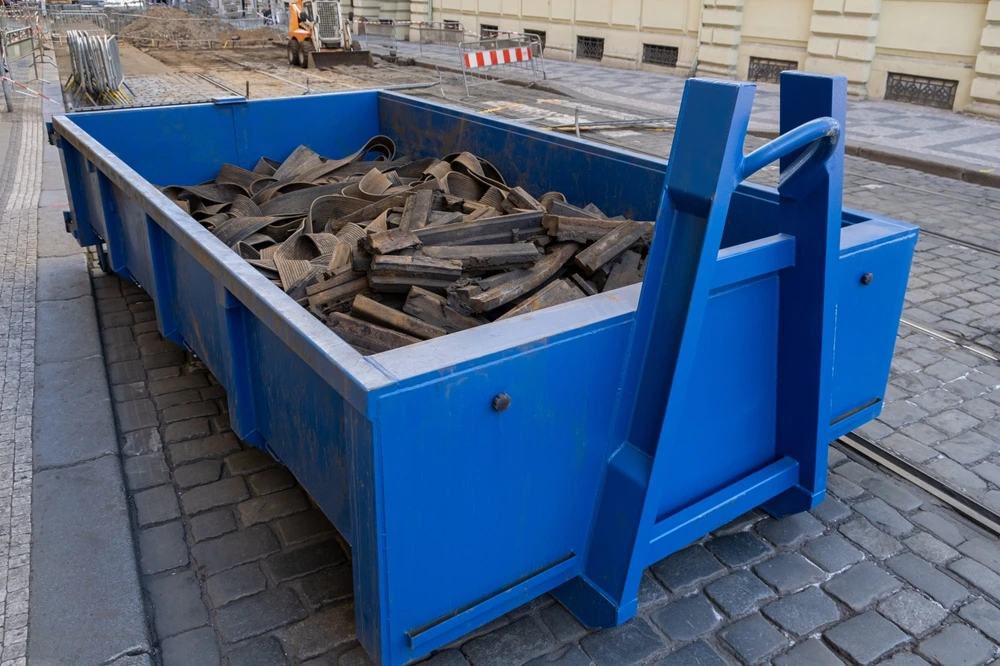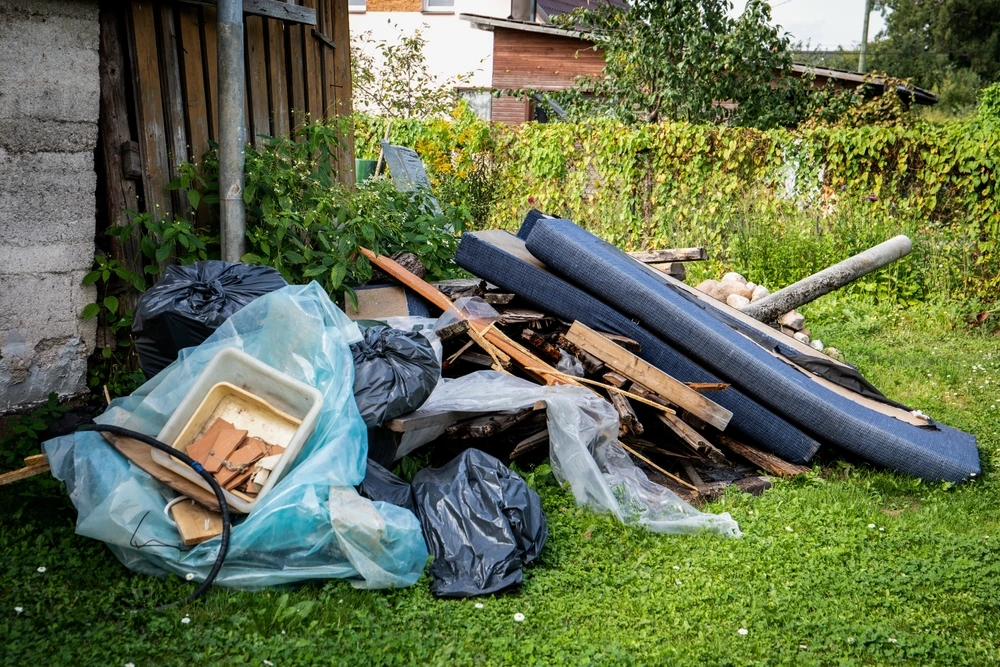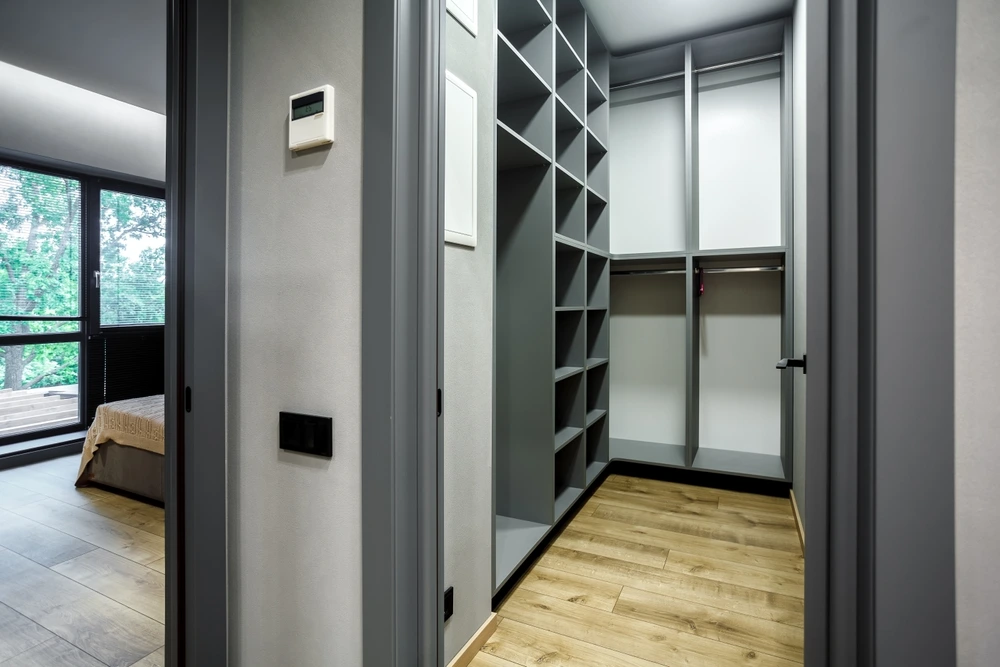July 25, 2024 - Benjamin Ehinger
Gazebo Removal: Efficient Strategies for Safe Dismantling
CALL NOW 844-762-8449
Removing a gazebo can seem like a daunting task for any homeowner. Assessing the stability and condition of your gazebo before starting the removal process is crucial. You’ll need to gather the right tools and, perhaps, some extra hands to help with the task.
Start by carefully disassembling the gazebo, beginning with the roof and working your way down. You might need tools like a wrench, wire cutters, and screwdrivers. Don’t forget to reserve a construction dumpster rental from Waste Removal USA to manage the debris effectively and ensure an environmentally friendly disposal.
Proper planning and preparation will make the process smoother. Store any reusable parts and make note of any structural details that may help if you decide to rebuild or repurpose the gazebo.
 Removing a gazebo involves careful dismantling of its components and responsible disposal of the waste material. Following these steps ensures an efficient and eco-friendly removal process.
Removing a gazebo involves careful dismantling of its components and responsible disposal of the waste material. Following these steps ensures an efficient and eco-friendly removal process.
 Properly dismantling and disposing of a gazebo affects not only your immediate environment but also the broader ecosystem. There are eco-friendly disposal methods and opportunities for recycling and donating materials that can ease the ecological impact.
Properly dismantling and disposing of a gazebo affects not only your immediate environment but also the broader ecosystem. There are eco-friendly disposal methods and opportunities for recycling and donating materials that can ease the ecological impact.
 Waste Segregation on Construction Job Sites: Best Practices for Efficiency and Sustainability
Waste Segregation on Construction Job Sites: Best Practices for Efficiency and Sustainability
Date: September 06 ,2024
 Junk Removal in Mount Pleasant SC: Efficient Services for a Cleaner Community
Junk Removal in Mount Pleasant SC: Efficient Services for a Cleaner Community
Date: September 06 ,2024
Key Takeaways
- Assess your gazebo’s condition before removal
- Disassemble methodically from top to bottom
- Rent a roll-off dumpster for effective debris management
Assessing the Gazebo for Removal
Assessing a gazebo for removal involves examining its stability and identifying the materials and tools required for the project. Ensuring a thorough assessment will help you dismantle and dispose of your gazebo safely and efficiently.Determining Structure Stability
Begin by examining the structure of your gazebo to determine its stability. Check for signs of wear and tear such as rot in wooden gazebos or rust in metal structures. If your gazebo is made of concrete or has concrete elements, look for cracks or other damage that may affect stability. Inspect the joints and connections between various parts of the gazebo. Ensure that all bolts, screws, and fasteners are secure. If you find any loose or damaged elements, plan how to safely dismantle these areas to prevent accidents. Consider the gazebo’s age as older structures may have weakened over time. If you are unsure about the stability, consult a professional or someone with experience in gazebo dismantling. Using a wrench to test the tightness of bolts, and a pry bar to gently check the connections, can also provide insights into the structural integrity.Material and Tool Assessment
Once you have assessed the stability, identify the materials your gazebo is made of, such as wood, metal, or concrete. This will help you determine the appropriate tools needed for removal. Common tools include screwdrivers, wrenches, pry bars, and safety equipment like gloves and goggles. For wooden gazebos, ensure you have saws or cutting tools if any parts need to be cut. Metal gazebos may require specialized tools such as metal cutters or grinders to deal with rusted bolts or connections. Consider renting a local dumpster to dispose of debris efficiently. This is particularly useful if your gazebo is large or made of heavy materials. Evaluate whether you need additional help, especially for large or heavy components. Having the right materials and tools on hand will make the removal process smoother and safer.Planning and Preparation
Effective gazebo removal requires careful planning and preparation. Essential steps include scheduling an appointment with professionals, obtaining the necessary permits, and ensuring the work area is ready for the task.Setting an Appointment with Professionals
For a seamless and efficient process, consider setting an appointment with professionals experienced in gazebo removal. Experts from local services in California, such as Brea and Whittier, can provide valuable assistance. These professionals are equipped to handle any complications and can ensure that the gazebo is removed safely and effectively. Hiring skilled workers also means they are likely insured and licensed, reducing your liability. Additionally, they can offer insights on patio or deck removal and proper disposal methods for any debris.Obtaining Necessary Permits
Depending on your location, you may need to obtain permits before starting the gazebo removal. It’s crucial to check with local authorities to understand the specific requirements in your area. In cities like Brea and Whittier, permit regulations might vary. Securing these permits in advance prevents legal issues and ensures that your project complies with local building codes. Keep in mind that failing to obtain the necessary permits can result in fines or delays in your project.Preparing the Work Area
Preparing the work area is essential for a safe and efficient gazebo removal. Begin by clearing the area of any furniture or outdoor equipment. This reduces tripping hazards and provides a clear space for workers. It’s also advisable to rent a roll-off dumpster to dispose of debris efficiently. This helps in managing waste and keeping the work site organized. Lastly, inform your neighbors about your plans to minimize disruptions. By following these steps, you can ensure that the gazebo removal process is smooth and straightforward.Executing the Removal Process
 Removing a gazebo involves careful dismantling of its components and responsible disposal of the waste material. Following these steps ensures an efficient and eco-friendly removal process.
Removing a gazebo involves careful dismantling of its components and responsible disposal of the waste material. Following these steps ensures an efficient and eco-friendly removal process.
Dismantling the Gazebo
Begin by removing the roof. For gazebos with a fabric canopy, undo any Velcro straps, ties, or screws that hold the canopy in place. If the roof is made of panels, remove them one at a time, starting from the top and working your way down. This prevents the frame from collapsing unexpectedly. Next, disassemble the frame. Start with any decorative elements and then move on to the main structural supports. Keep all screws and bolts organized so you can dispose of them properly. Be mindful of safety; use a ladder securely, and have assistance if needed to handle larger pieces. Wrap up by checking for any remaining small parts or fasteners that may have fallen during the process. Clearing these ensures a safe and thorough dismantling process.Dealing with Waste Material
Sorting and disposing of the dismantled gazebo components responsibly is crucial. Metal parts can be taken to a recycling center, while wood and other organic materials can either be recycled or composted, depending on local regulations. Consider using a driveway dumpster rental for large projects. This option simplifies the clean-up and disposal process, providing a convenient place to collect and transport waste to the appropriate facilities. For non-recyclable materials, verify if they need to go to a landfill or if there are specialized disposal services available. Addressing waste responsibly minimizes environmental impact and ensures an efficient clear-up of the project area.Final Considerations
When removing a gazebo, it’s essential to plan for ongoing maintenance needs and think about potential replacement options. Both of these considerations can play a significant role in your overall satisfaction with the project.Maintenance and Follow-Up
After dismantling your gazebo, take the time to properly clean and assess the site. Look for any leftover debris, and thoroughly inspect the area to ensure it’s free of hazards like nails or screws. Renting a roll-off dumpster can be particularly useful for managing waste during this process. If you plan on reassembling the gazebo in the future, store the screws, bolts, and other components in clearly labeled containers. Regularly check these stored items for rust or damage to ensure they stay in good condition. Additionally, consider applying a protective coating to metal parts to prevent corrosion. It’s also wise to evaluate the quality of leftover materials. Boards and beams that are still in good shape can be repurposed for other projects, potentially saving you time and money in the long run.Evaluating Replacement Options
Deciding on a replacement for your gazebo can be just as involved as the removal process. Start by evaluating the space you have and determine what structure, if any, would best fit your needs and lifestyle. Consider options like pergolas, patio covers, or even a new gazebo if the location proves suitable. Look into models that prioritize quality and ease of construction to ensure a smooth installation experience. You may also want to assess the various materials available, from wood to metal, based on durability and aesthetic preferences. An accurate estimate of replacement costs should account for not only the structure itself but also any professional labor required for installation. If you have construction experience, you might opt to assemble the new structure yourself, thereby reducing costs. Always factor in long-term maintenance requirements to ensure your new addition remains in top condition for years to come.Environmental Considerations and Disposal
 Properly dismantling and disposing of a gazebo affects not only your immediate environment but also the broader ecosystem. There are eco-friendly disposal methods and opportunities for recycling and donating materials that can ease the ecological impact.
Properly dismantling and disposing of a gazebo affects not only your immediate environment but also the broader ecosystem. There are eco-friendly disposal methods and opportunities for recycling and donating materials that can ease the ecological impact.
Eco-Friendly Disposal Options
When removing a gazebo, it’s important to minimize its environmental footprint. One way to achieve this is by using the right dumpster rental from an eco-friendly company like Waste Removal USA. This helps you efficiently manage debris and ensures waste is handled responsibly. Pressure-treated wood from gazebos should not be burned or left to decay. It’s essential to dispose of this material correctly to avoid soil contamination. Consider taking it to designated disposal facilities that can treat and recycle the wood. Removing rafters, support beams, and other parts before dismantling the entire structure makes it easier to sort materials. Yard waste like leaves, small branches, and other biodegradable items should be composted rather than sent to a landfill.Recycling and Donation
Recycling parts of your gazebo can prevent usable materials from ending up in landfills. Many components like metal screws, nails, and bolts can be recycled at local facilities. Wooden parts can sometimes be repurposed into new, functional structures. Consider also donating your gazebo parts to organizations that accept building materials. Items like wooden beams, metal connectors, and even intact panels are valuable to charities focused on construction and renovation. If your gazebo is in good condition, you can list it on platforms where people seek free or low-cost second-hand building materials. This not only reduces waste but also supports community-driven recycling efforts. Recycling and donation reduce landfill use and promote sustainable practices. By making these efforts, you contribute positively to your community and the environment.Frequently Asked Questions
Gazebo removal can be a straightforward process if you know what steps to take and which services to use. Here are some common questions about gazebo removal, including costs, DIY steps, and finding services.What are the typical costs associated with professional gazebo removal?
The cost of professional gazebo removal typically starts at around $89. This can vary depending on the size and complexity of the structure.Can a gazebo be safely removed as a DIY project, and what are the steps?
Yes, you can remove a gazebo yourself by following these steps:- Clear out any furniture or decorations.
- Use a wrench to loosen and remove bolts.
- Disconnect joints or connectors. For larger frameworks, you might need a power drill, saw, and hammer. A dumpster rental can help manage debris disposal.
Are there services that offer free removal of old gazebos?
Free removal services are rare. However, some companies may offer discounts or special deals.How do I find reliable gazebo removal services in my area?
Look for reviews online and check with local outdoor living or demolition companies. Sites like Waste Removal USA provide upfront pricing and scheduling options.What factors influence the price of gazebo demolition and removal?
Prices can be influenced by the gazebo’s size, material, and location. Additional costs may arise from difficult access or the need for special tools.What is the process of dismantling a metal pergola?
Dismantling a metal pergola involves:- Using a power drill to remove screws and bolts.
- Disconnecting metal joints and supports.
- Carefully lowering and removing sections.
RECENT BLOGS
 Waste Segregation on Construction Job Sites: Best Practices for Efficiency and Sustainability
Waste Segregation on Construction Job Sites: Best Practices for Efficiency and Sustainability
Date: September 06 ,2024
 Junk Removal in Mount Pleasant SC: Efficient Services for a Cleaner Community
Junk Removal in Mount Pleasant SC: Efficient Services for a Cleaner Community
Date: September 06 ,2024
Our Reviews
Brian Healy
1725553543
Heather was so very pleasant, informative and charming. Next time… I will use you again.
Brandi Childers
1724853716
Ricardo helped me with my reservation. He made everything super clear and answered all my questions to help me pick the right dumpster to rent!
Steven Hewett
1724785537
Heather made the sales and scheduling experience extremely easy. Thank you for having great employees that care about conducting great business.
Jackson Vandiver
1724703158
Great service and fantastic customer service department. I would use them again.
kristin hester
1723492493
Vanessa was amazing!
LATEST BLOGS





